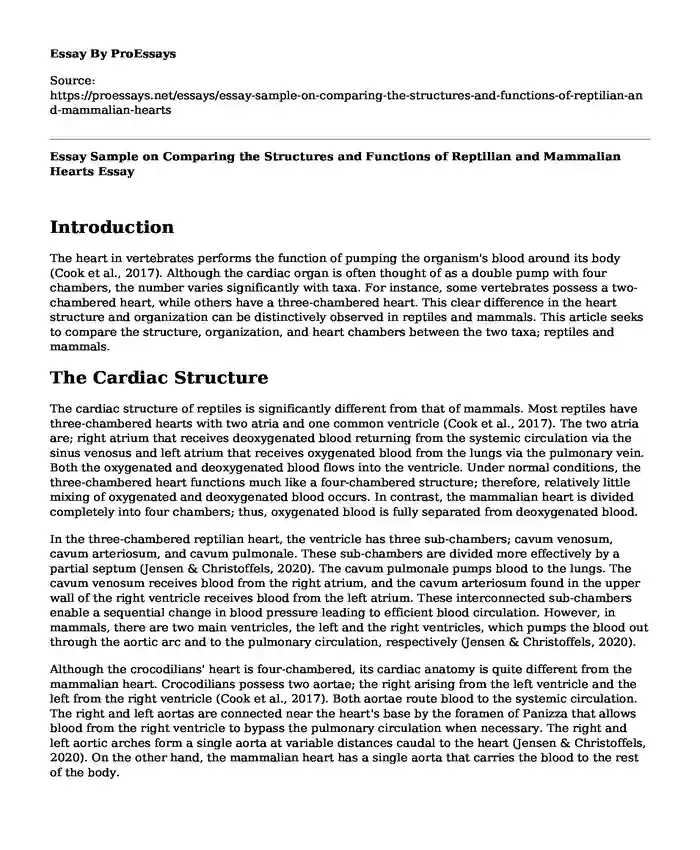Introduction
The heart in vertebrates performs the function of pumping the organism's blood around its body (Cook et al., 2017). Although the cardiac organ is often thought of as a double pump with four chambers, the number varies significantly with taxa. For instance, some vertebrates possess a two-chambered heart, while others have a three-chambered heart. This clear difference in the heart structure and organization can be distinctively observed in reptiles and mammals. This article seeks to compare the structure, organization, and heart chambers between the two taxa; reptiles and mammals.
The Cardiac Structure
The cardiac structure of reptiles is significantly different from that of mammals. Most reptiles have three-chambered hearts with two atria and one common ventricle (Cook et al., 2017). The two atria are; right atrium that receives deoxygenated blood returning from the systemic circulation via the sinus venosus and left atrium that receives oxygenated blood from the lungs via the pulmonary vein. Both the oxygenated and deoxygenated blood flows into the ventricle. Under normal conditions, the three-chambered heart functions much like a four-chambered structure; therefore, relatively little mixing of oxygenated and deoxygenated blood occurs. In contrast, the mammalian heart is divided completely into four chambers; thus, oxygenated blood is fully separated from deoxygenated blood.
In the three-chambered reptilian heart, the ventricle has three sub-chambers; cavum venosum, cavum arteriosum, and cavum pulmonale. These sub-chambers are divided more effectively by a partial septum (Jensen & Christoffels, 2020). The cavum pulmonale pumps blood to the lungs. The cavum venosum receives blood from the right atrium, and the cavum arteriosum found in the upper wall of the right ventricle receives blood from the left atrium. These interconnected sub-chambers enable a sequential change in blood pressure leading to efficient blood circulation. However, in mammals, there are two main ventricles, the left and the right ventricles, which pumps the blood out through the aortic arc and to the pulmonary circulation, respectively (Jensen & Christoffels, 2020).
Although the crocodilians' heart is four-chambered, its cardiac anatomy is quite different from the mammalian heart. Crocodilians possess two aortae; the right arising from the left ventricle and the left from the right ventricle (Cook et al., 2017). Both aortae route blood to the systemic circulation. The right and left aortas are connected near the heart's base by the foramen of Panizza that allows blood from the right ventricle to bypass the pulmonary circulation when necessary. The right and left aortic arches form a single aorta at variable distances caudal to the heart (Jensen & Christoffels, 2020). On the other hand, the mammalian heart has a single aorta that carries the blood to the rest of the body.
Circulatory Mechanism
Reptiles have a unique circulatory mechanism compared to that of the mammals. During long periods of submergence, the heart shunts blood from the lungs toward the stomach and other organs (Jensen & Christoffels, 2020). The two main arteries leave the same part of the heart and take the blood to two different parts; to the lungs and the rest of the body. The reptilian heart has a foramen of Panizza, a hole in the heart between the two ventricles, allowing the blood to flow from one side of the heart to the other (Jensen & Christoffels, 2020). Besides, there is a specialized connective tissue that slows the flow of blood to the lungs. However, in the mammalian heart, the double circulation mechanism improves the efficiency of blood circulation.
Conclusion
In conclusion, there are distinctive structures, organizations, and heart chambers in mammals and reptiles. For instance, three heart chambers with two atria and one ventricle in most reptiles against the more developed four chambers with two atria and two ventricles in mammals, the existence of two aortae in crocodiles while only one in mammals, and unique circulatory mechanism in reptiles against the double mechanism in mammals.
References
Cook, A. C., Tran, V. H., Spicer, D. E., Rob, J. M., Sridharan, S., Taylor, A., ... & Jensen, B. (2017). Sequential segmental analysis of the crocodilian heart. Journal of Anatomy, 231(4), 484-499.
https://onlinelibrary.wiley.com/doi/full/10.1111/joa.12661
Jensen, B., & Christoffels, V. M. (2020). Reptiles as a model system to study heart development. Cold Spring Harbor Perspectives in Biology, 12(5), a037226.
https://cshperspectives.cshlp.org/content/12/5/a037226.short
Cite this page
Essay Sample on Comparing the Structures and Functions of Reptilian and Mammalian Hearts. (2023, Oct 02). Retrieved from https://proessays.net/essays/essay-sample-on-comparing-the-structures-and-functions-of-reptilian-and-mammalian-hearts
If you are the original author of this essay and no longer wish to have it published on the ProEssays website, please click below to request its removal:
- The Process of Blood Flow and Sporting Events
- Why Human Genetic Engineering Should Be Allowed for Medical Purposes
- Course Work Example on Hormones
- Essay Sample on Rights of Animals
- Argumentative Essay: Animal Testing Should Be Forbidden
- Essay Example on Kew Gardens - Royal Botanic Gardens in London, UK
- Essay Example on Jawed Fish: Evolution of Jaw-mouth Vertebrates







